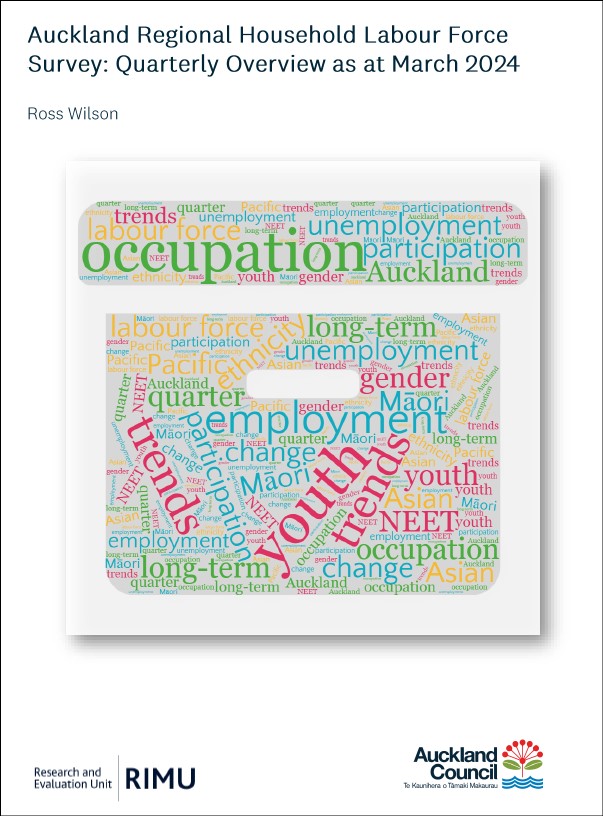Auckland regional household labour force survey: quarterly overview as at March 2024
Author:
Ross WilsonSource:
Auckland Council Research and Evaluation Unit, RIMU | Statistics New ZealandPublication date:
2024Topics:
EconomyAn overview of labour force participation in Auckland, as indicated by results of Stats NZ's quarterly Household Labour Force Survey. HLFS
Overview and highlights
- For the March 2024 quarter, compared to the preceding quarter (December 2023):
- Auckland’s unemployment rate was 4.8%, higher than 4.2% in December 2023, (but lower than nearly all of 2009 to 2020).
- The number of people who were unemployed rose to 50,200 (+6,100, a 12% increase).
- The number of people employed fell to 1,002,800 (-11,800, a 12% decrease).
- The number of people not in the labour force (NILF) rose to 377,500 (+17,900).
- The labour force participation rate (LFPR) fell to 73.6%, the second-highest March quarter on record (since at least 1995). LFPR since 2021 have been at record levels.
In addition, for the March 2024 quarter:
- The rate of people aged 15 to 24 not in employment, education or training (NEET) was 14.4%, slightly above the rest of New Zealand (13.9%).
Over the year ended March 2024, compared to the year ended March 2023:
- The unemployment rate averaged 4.1%, higher than a year earlier (2023: 3.4%).
- The unemployment rate was highest and rose most for young people aged 15 to 19 (+4.8% to 19.3%) and 20 to 24 (+1.2% to 7.9%), while all other ages rose by less: 55 and over (+0.8% to 2.7%), 25 to 39 (+0.5% to 3.4%) and 40 to 54 (+0.5% to 2.5%).
- The unemployment rate for females averaged 4.6%, above the previous year (3.9%). The rate for males averaged 3.7% (above 2.9% a year prior), so the gap between males and females (0.9%) remained similar to the 20-year average (0.8%).
- Unemployment rates varied between the main ethnic groups, but rose for each of them: European (3.3%, up from 2.5%), Asian (3.4%, up from 2.9%), Pacific peoples (7.9%, up from 6.2), and Māori (9.2%, up from 7.5%).
- The labour force participation rate (LFPR) averaged 74.3%, slightly higher than a year earlier (73.6%) and similar to the record levels prevailing since year ended June 2023.
- The LFPR rose similarly for females (69.6%, up 0.6% from 69.0%) and for males (79.1%, up 0.8% from 78.3%); the differential (9.5%) has halved since 1995 (19.0%).
- Labour force participation rates fell slightly for those aged 15-19 (down 1.7% to 45.7%) and 20 to 24 (down 1.2% to 80.0%) rose slightly for 25-39 (88.2%, up 0.8%) and unchanged for 40-54 (88.9%) and 55+ (52.4% - technically a negligible rise).
- Labour force participation rates by ethnic group rose for European (75.4%, up 1.0%), with minimal changes for Asian (77.7%, up 0.1%), Māori (69.2%, up 0.3%) and Pacific (66.9%, down 0.2%). All groups have been at or near record levels in 2022 and 2023.
In addition, over the year ended March 2024:
- The annual average NEET rate for Auckland was 12.2%, similar to the rest of New Zealand (12.0%), and slightly above the year ended March 2023 (11.9%).
- Auckland NEET rates were highest for Māori (23.5%) and Pacific (17.8%) ethnicities, and for the Southern Initiative area (19.4%).
- Auckland’s NEET rate was higher for those aged 20-24 (14.9%) than 15-19 (9.5%).
Overview published May 2024.
